Related Research Articles

Société des Avions Bernard was a French aircraft manufacturer of the early 20th century.

The Farman F.170 Jabiru was a 1925 single-engine airliner evolved from the F.121 Jabiru, built by the Farman Aviation Works.

The Bernard SIMB AB 14 was a 1920s French single-seat sesquiplane fighter aircraft designed and built by the Société Industrielle des Métaux et du Bois (SIMB). With a reluctance of the French authorities to purchase monoplanes the Bernard 14 was designed as a sesquiplane with Y-form struts bracing the wings on each side. It was powered by a Hispano-Suiza 12Hb inline piston engine and had a fixed tailskid landing gear. While on a test flight on 22 February 1926 the aircraft suffered a catastrophic structural failure of the upper wing and the only Bernard 14 was destroyed.
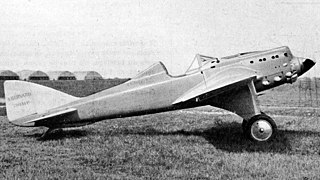
The Bernard 20 was a 1920s French single-seat monoplane fighter aircraft designed and built by the Société des Avions Bernard. Originally displayed as a mock-up at the 1928 Paris Air Show it was a low-wing monoplane based on the Bernard V2 racer. The prototype powered by a 400 hp (298 kW) Hispano-Suiza 12Jb inline piston engine first flew in July 1929 from Orly. With its racing inheritance, in 1930 the aircraft flew at a speed of 280 km/h (174 mph). With the lack of interest by the French authorities for monoplanes the project was abandoned after 18 months of test flying.
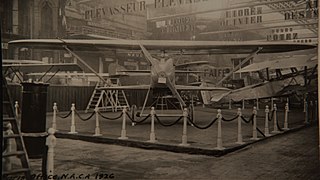
The Bernard 15 C1 or Bernard SIMB AB 15 was a 1920s French single-seat sesquiplane fighter aircraft designed and built by the Société Industrielle des Métaux et du Bois (SIMB). With the structural failure of the earlier Bernard 14 the Bernard 15 was an improved variant with a greater span upper wing. It was powered by a Hispano-Suiza 12Hb inline piston engine and had a fixed tailskid landing gear. The performance was not an improvement on the Bernard SIMB AB 14 and only the prototype was built.

The Bernard 70 was a 1920s design for a French single-seat monoplane fighter aircraft by the Société des Avions Bernard. It was not built but was developed into a racing monoplane designated the Bernard S-72,. It was further developed into single-seat fighters, the Bernard 74-01 and Bernard 74-02, although only two of the fighters were built.

The Bernard H.52 was a French floatplane fighter aircraft of the 1930s. It was a single engine, single-seat monoplane built in the hope of being selected by the French Navy. Two prototypes were built, but no production followed.

The Bernard 82 was a French single-engined long-range monoplane bomber designed and built by Société des Avions Bernard. Only two prototypes were built and the type did not enter production.
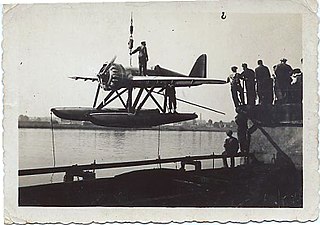
The Bernard H.V.40 was a racing seaplane designed by Société des Avions Bernard for the French government to compete in the 1929 Schneider Trophy.
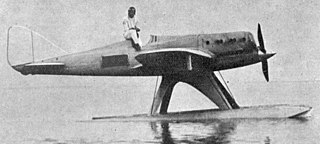
The Bernard H.V.41 was a racing seaplane designed by Société des Avions Bernard for the French government to compete in the 1929 Schneider Trophy.

The Bernard H.V.42 was a racing seaplane designed by Société des Avions Bernard for the French government for use of the French Schneider Trophy team.
The Bernard SIMB V.1 was a French single seat racing monoplane designed to compete for the 1924 Beaumont Cup. It crashed on its first flight and was not rebuilt.
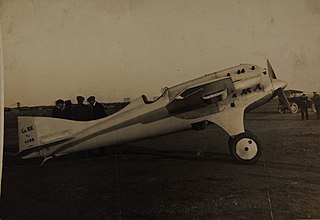
The Bernard SIMB V.2 was a single-seat, single-engine French monoplane, built in the mid-1920s. It was originally designed for racing but was adapted for a successful attempt on the world absolute speed record.
The Bernard SIMB AB 10 was a French single-engine, single-seat, highly streamlined, cantilever, all-metal low-wing monoplane of advanced design. It first flew in 1924 but was not ordered into production.

The Bernard SIMB AB 12 was a French single engine, single-seat monoplane fighter aircraft built in the 1920s. Though advanced for its time, it failed to gain a production order and only one was built.
The Bernard H 110 was a single engine, single seat monoplane floatplane fighter designed for a French Navy competition. It flew in 1935 but had only made four test flights when the Bernard company was declared bankrupt, preventing further development.
The Bernard 160 was a three engine, multi-role monoplane designed in the early 1930s to meet a French government call for aircraft suited to policing and medical duties in its African colonies. Two prototypes were built and tested, but no further orders were placed.
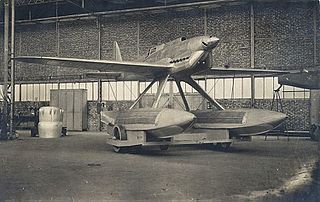
The Bernard H.V.220 was a 1930s French racing seaplane and the last attempt by Bernard compete in the Schneider Trophy race. Delays caused by engine problems meant the aircraft was abandoned and never flown.

The Bernard H.V.120 was a 1930s French racing seaplane designed and built by Bernard to compete in the Schneider Trophy race. Delays caused by engine problems and the crash of the second aircraft delayed entry and the aircraft did not race in the competition.

Jean Hubert was a French aviation pioneer and aircraft designer. He was the Chief Engineer of Société des Avions Bernard.